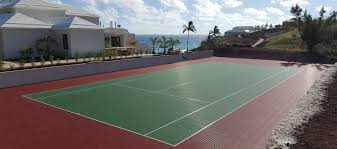
Tennis courts are more than just a playing field—they directly influence the game’s pace, player performance, and maintenance efforts. Choosing the right tennis court flooring can transform both recreational and professional play. This guide explores the main types of tennis court surfaces, their characteristics, pros and cons, and maintenance needs, helping you make an informed decision.
The Four Main Types of Tennis Court Surfaces
Tennis courts commonly feature one of four surface categories: hard courts, clay courts, grass courts, and synthetic surfaces. Each surface has unique attributes and offers distinct gameplay experiences.
1. Hard Courts
Characteristics:
Hard courts are made from asphalt or concrete and are coated with acrylic layers to provide a smooth, even playing surface. They are among the most widely used court types globally, often seen in professional tournaments like the US Open and Australian Open.
Advantages:
- Versatility: Hard courts offer a balance of speed and bounce, making them suitable for a wide range of playing styles.
- Durability: They withstand frequent use and various weather conditions, lasting several years with proper upkeep.
- Consistency: The even surface ensures predictable ball bounce, ideal for competitive play.
Disadvantages:
- Impact on players: Because of their firmness, they can be harsh on players’ joints over prolonged periods.
- Temperature sensitivity: The surface can heat up significantly under direct sunlight, affecting comfort during play.
Maintenance:
Hard courts are relatively low-maintenance compared to other surfaces. Regular cleaning to remove dirt, debris, and moss is essential. Periodic resurfacing, usually every 5-7 years, helps maintain the court’s smoothness and playability.
2. Clay Courts
Characteristics:
Clay courts are made from crushed brick, shale, or natural stone. They are widely recognized for their iconic red or green color and are the surface of choice for tournaments like the French Open.
Advantages:
- Slower gameplay: Clay courts slow down the ball and produce high bounce, lengthening rallies and favoring baseline players.
- Softer surface: Clay courts are gentler on players’ joints and minimize the risk of injuries caused by high-impact movements.
Disadvantages:
- Weather sensitivity: Clay courts become slippery when wet and require time to dry before resuming play.
- Higher maintenance: They demand frequent grooming to smooth out footprints, re-level the surface, and control moisture levels.
Maintenance:
Clay courts need daily upkeep. This includes sweeping to maintain a flat surface, controlling moisture to prevent cracks or excessive dryness, and replenishing clay material over time. These steps ensure the court remains playable and aesthetically pleasing.
3. Grass Courts
Characteristics:
Grass courts, often associated with Wimbledon, feature natural grass grown on a level bed of compacted soil. They are considered the most traditional tennis court surface.
Advantages:
- Fast gameplay: Grass courts produce a low and irregular bounce, favoring serve-and-volley players and quick reflexes.
- Luxurious feel: The green, manicured look of a grass court adds an element of prestige and charm.
Disadvantages:
- Weather limitations: Grass courts are heavily affected by rain, making them unplayable during and immediately after wet conditions.
- Maintenance efforts: Maintaining a grass court is labor-intensive, requiring regular mowing, watering, and weeding.
Maintenance:
Grass courts need frequent mowing to keep the grass at just the right height and density. They also require consistent irrigation, aeration to prevent soil compaction, and re-seeding to fill worn patches. This level of care ensures a playable surface throughout the season.
4. Synthetic Surfaces
Characteristics:
Synthetic surfaces, such as carpet or artificial turf, are an increasingly popular option due to their versatility and cost-effectiveness. These surfaces mimic natural materials like grass or clay and are often installed in indoor facilities.
Advantages:
- All-weather usability: Synthetic surfaces are resistant to weather changes, offering reliable gameplay in diverse conditions.
- Low upkeep: They require far less maintenance than clay or grass courts.
- Customizability: Synthetic surfaces can be tailored to mimic specific characteristics of other court types, like the speed of grass or the cushioning of clay.
Disadvantages:
- Durability concerns: Over time, synthetic surfaces can wear down, especially in high-traffic areas, leading to potential unevenness in the playing field.
- Cost: High-quality synthetic materials and installation can be expensive upfront.
Maintenance:
Synthetic courts demand routine cleaning to remove debris and maintain an even surface. Occasionally, they may require infill replenishment or repairs to prevent surface damage.
Choosing the Right Tennis Court Surface
When choosing a tennis court surface, several factors come into play:
- Usage: Consider whether the court will be used for professional tournaments, recreational play, or both.
- Climate: Evaluate the region’s climate—grass and clay courts may suffer in areas with frequent rainfall or extreme temperatures.
- Maintenance: Determine how much time and budget are available for ongoing maintenance.
- Gameplay Style: Different surfaces cater to different play styles. For example, baseline players may prefer clay courts, while serve-and-volley players might opt for grass.
Final Thoughts
From hard courts to natural grass, the choice of tennis court flooring significantly impacts gameplay and maintenance. While hard courts are durable and versatile, clay courts offer a unique slower pace. Grass courts deliver an elegant experience but demand intensive care, and synthetic surfaces provide an adaptable and low-maintenance alternative.
Selecting the right court surface requires a careful balance of functional needs and personal preferences. With proper upkeep, whichever type you choose will provide years of enjoyment and performance. Whether you’re upgrading an existing facility or building a new one, understanding your options is the first step to creating a court that truly meets the needs of players and staff alike.







